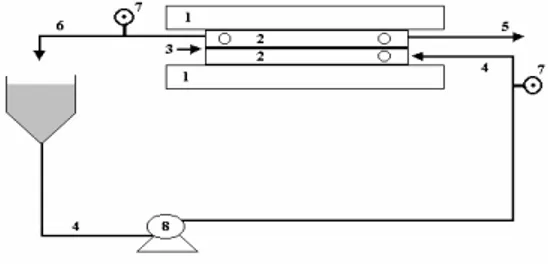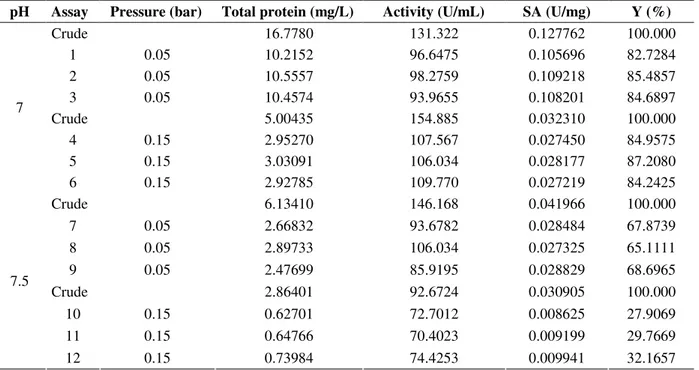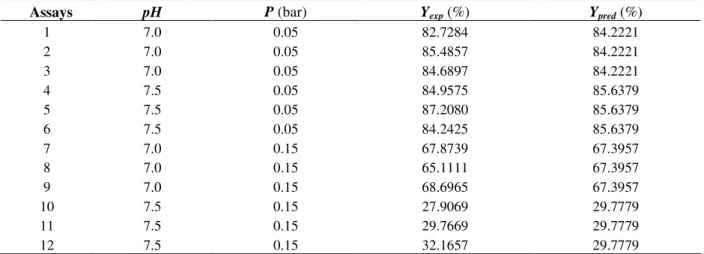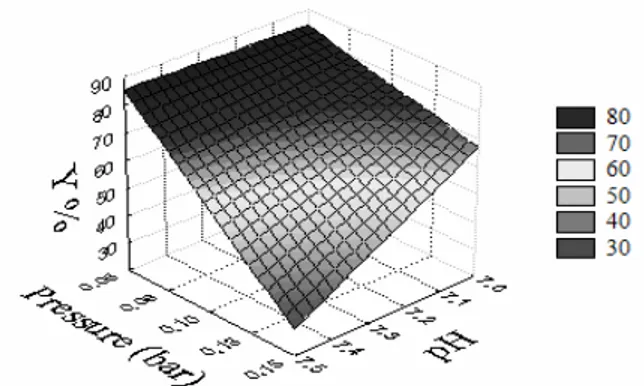Vol. 52, n. 2 : pp. 457-464, March-April 2009
ISSN 1516-8913 Printed in Brazil BRAZILIAN ARCHIVES OF BIOLOGY AND TECHNOLOGY
A N I N T E R N A T I O N A L J O U R N A L
Concentration by Membrane Separation Processes of a
Medicinal Product Obtained from Pineapple Pulp
Francisco Luiz Gumes Lopes
1, João Baptista Severo Júnior
2, Roberto Rodrigues de Souza
2,
Daniela Diniz Ehrhardt
3,
José Carlos Curvelo Santana
4and Elias Basile Tambourgi
5*1Departamento de Administração e Processos Industriais e Químicos; Centro Federal de Educação Tecnológica da
Bahia, Salvador - BA - Brasil. 2Departamento de Engenharia Química; Universidade Federal de Sergipe; São Cristóvão - SE - Brasil. 3Faculdade de Ciências Farmacêuticas; Pontifícia Universidade Católica de Campinas; Campinas - SP - Brasil. 4Departamento de Ciência Exatas; Universidade Nove de Julho; São Paulo - SP - Brasil.
5Faculdade de Engenharia Química; Universidade Estadual de Campinas; Av. Albert Einstein, 500; C. P.: 6066;
13083-970; Barão Geraldo; Campinas - SP - Brasil
ABSTRACT
The concentration of pineapple juice is needed to retain the bromelain activity and to standardize the composition and proteolytic activity. Thus, this work aimed to obtain a pure bromelain extract from the Ananas comosus L. Merril juice by membrane separation process. A 22 experimental planning was used to study the influence of pH and transmembrane pressure on the activity recovery by micro-filtration using a plain membrane. In second step, this enzyme was purified by the ultra-filtration using a 10 kDa millipore kit. The best operation condition to bromelain concentration using the plain membrane was at pH 7.5 and transmembrane pressure of 0.05 bar, while 85% of bromelain activity was recovered. Ultra-filtration retained 100% of proteolytic activity and concentrated in 10 fold the bromelain extract. SDS-PAGE electrophoresis showed that the ultra-filtrated had high purity and the bromelain from A. comosus pulp had a molecular weight of 24.5 kDa.
Key words: Ananas comosus, bromelain, membrane separation processes, purification, medicinal product
*
Author for correspondence: eliastam@feq.unicamp.br
INTRODUCTION
Bromelain is a mixture of proteinases derived from pineapple stem, which is sold as a nutritional supplement to “promote digestive health” and as an anti-inflammatory medication in some developed countries (Hale et al., 2005a and 2005b; Wen et al., 2006). Bromelain is clinically used from the pineapple extract and the natural product. Studies have reported, anti-inflammatory and immunomodulatory activities (Hale et al., 2005a
and 2005b; Secor et al., 2005; Wen et al. 2006). It has been applied in the anticancer activity (Harrach et al., 1994), in the immunization of influenza virus (Vareniková, et al. 1995) and in the treatment of allergic airway disease (Secor et al., 2005). It is also used in cosmetic compositions (Chatsworth, 1996). Adverse results had been reported on an allergic activity of bromelain caused by the inhalations of beer or wheat snack (Anton et al., 2005).
abdominal postoperative rats. Results showed that bromelain increased the wet weight, dry weight, water content and number of fecal pellets in laparotomized plus mechanically manipulated rats, suggesting improvement of postoperative ileums. Hale et al. (2005a) studied the treatment of the colonic inflammation with oral bromelain in patients. They observed that the bromelain had anti-inflammation activity, but is need additional studies of this complementary biologically based approach to the treatment of colonic inflammation.However, bromelain is instable and frequently is deactivated spontaneously, due the action of the components of the medium. Concentrated bromelain solutions are more resistant to spontaneous inactivation of their proteolytic activity than are the dilute solutions, with the proteinase stability in the order of stem bromelain>fruit bromelain ananain. The proteolytic activity of concentrated bromelain solutions remains relatively stable for at least one week at room temperature, with minimal inactivation by multiple freeze–thaw cycles or exposure to the digestive enzyme trypsin. The relative stability of concentrated versus dilute bromelain solutions to inactivation under the physiologically relevant conditions suggests that delivery of bromelain as a concentrated bolus would be the preferred method to maximize its proteolytic activity in vivo (Arroyo-Reyna and Hernández-Arana, 1995; Hale et al., 2005b). Other problem in vivo studies using bromelain is the limitation by the lack of assays to control for potential differences in the composition and proteolytic activity of this naturally derived proteinase mixture (Hale et al., 2005b).
Thus, the concentration of pineapple juice is needed to retain the bromelain activity and to standardize the composition and proteolytic activity. According to Sigma (1996), bromelain enzyme had price of U$ 300 per gram of protein purified. These factors have been stimulated the researches aiming to concentrate, recover and/or purify the bromelain from pineapple. The purification of bromelain from pineapple juice was studied using sequential batch membrane processing systems which included micro-filtration (MF) and ultra-micro-filtration (UF), followed by ammonium sulfate extraction, ultracentrifugation and freeze drying (Doko et al., 1991); using the thermo-separation by poly(ethylene oxide) (PEO)– poly(propylene oxide) (PPO)– poly(ethylene oxide) (PEO) block
copolymers aqueous solutions (Rabelo et al., 2004) and using adsorption on the magnetic nano-particles of polyacrylic acid (PAA)-bound iron oxide (Chen and Huang, 2004).
The membrane Technologies e.g. micro-filtration (MF) and ultra-filtration (UF), as recent method used to separate the components of a solution based on molecular size differences, are much required for liquid foods, in juice processing, as well as protein isolate and concentrate production (Cassano et al., 2003; Howell et al., 1993; Sá et al., 2003). They are used in filtration, which long for concentrates and purifies enzymes and supports hydraulic pressure among 0.07 and 7 bar (Howell et al., 1993). Clarification and concentration of cajá, citrus and carrot juices and maize malt by integrated membrane processes have been reported which besides reducing the production costs, show several other advantages for quality and production yield (Cassano et al., 2003; Sá et al., 2003; Severo Junior et al., 2007a, 2007b).
The purpose of this work was to study the bromelain recovery, extracted from the pineapple (A. comosus L. Merril) juice, using flat membrane module and a millipore kit, aiming to retain the bromelain activity and to standardize the composition and proteolytic activity in a concentrated extract. For this, a 22 experimental planning was studied for the influence of pH (7.0 and 7.5) and transmembrane pressure (0.05 and 0.15 bar) on the activity recovery in micro-filtration process, as well as process optimization by RSM methodology and in optimal condition the purification was done by ultra-filtration process.
MATERIALS AND METHODS
Obtainment of pineapple juice
The pineapple (A. comosus L. Merril) fruit was provided by EMBRAPA (Aracaju, SE, Brazil), its juice was prepared at room temperature and pressure, using a pulp mass of 650 g that initially was passed to simple filtration through cotton to remove the dispersed solids. Phosphate buffer at pH 7.0 and 7.5 were used. The solution volume was adjusted to 1.0 L.
Enzyme assays
enzymatic activity was defined as the variation of one absorbance unit at 280 nm during 10 minutes at 35oC. Permeate and concentrate total protein concentration were determined by the modified Bradford method (1976) using BSA the standard protein.
Membrane module
A polyvinyl fluorite membrane (TECH-SEP-6501 model) with an area of 0.0225 m2 and a pore size
equal to 0.1 µm was used. The experiments were conducted in a membrane module composed of two flat props and between them: one membrane between two spacers. The feed flow circulation was tangential to the membrane surface, with a discontinuous operation and a concentrate recirculation. Figure 1 shows the scheme of experimental micro-filtration unit (Lopes, 2005, Severo Junior et al., 2007a, 2007b).
Figure 1 - Scheme of the micro-filtration unit used in experiments. While: 1 - iron plates, 2 - acrylic plates, 3 - membrane, 4 - feed flow, 5 - permeate, 6 - concentrate, 7 - manometer, 8 - pump
In a second step, the pre-concentrated extract was put into a 10 kDa millipore kit and the ultra-filtration (UF) was carried out at 4 ºC and 7000 rpm per 20 min. Salts, glycosides and other substances of small molecular weight were eliminated. Total volume was reduced to 10 times after UF process (Doko et al., 1991).
Experimental design and statistical analysis
The experiments were made using a factory design of the type 22, with two factors: pH (x1) and
transmembrane pressure, P (x2). Table 1 shows the
coded valor of factors. Yield of activity recovery (Y, %) was given in percent form (%) and was
used as response. Equation 1 is the form to obtain the yield of activity recovery. The pineapple extract was termed as crude and the filtered global permeate. Models evaluated were made by variance analyses (ANOVA) that was statistical analyses to authenticate the models based in the Gauss curve deviation. Process optimization was evaluated by the response surface methodology (Barros Neto et al., 1995 and 2001; Biazus et al., 2005; Ferreira et al., 2007; Rodriguez-Nogales et al., 2005; Severo Junior et al., 2007b).
100 * (%)
=
crude of activity specific
permeate global
of activity specific
Y (1)
Table 1 - Coded valor used in the experiment.
Levels Variables
-1 +1
pH, x1 7.0 7.5
P (bar), x2 0.05 0.15
Polyacrylamide gel electrophoresis
SDS-PAGE was performed on mini-PROTEAN II cell (Bio-Rad, USA) with 12 % acrylamide gel, using protein standard for molecular weight marker (Dermirkan et al., 2005; Nirmala and Muralikrishna, 2003). Proteins of UF extract were
20% (v/v) glycerol, 8% w/v) SDS and 0.04% (w/v) brome-phenol blue, was added to the protein sample and mixed with 2.5% (v/v) 2-mercapttoethanol. This mixture was boiled for 10 min prior to loading on the gels. The proteins were separated at constant amperage of 20 mA using the running buffer contained 25mM Tris, 192mM glycine, and 0.1% (w/v) SDS, pH 8.3. Separated proteins were visualized after fixation with coomassie brilliant blue G-250 (staining solution: 10% (v/v) phosphoric acid and 0.02 (w/v) coomassie).
RESULTS AND DISCUSSION
Results obtained are shown in Table 2, which describes the experimental conditions realized to bromelain enzymes recovery process. Table 3 shows the experimental and predicted results for activity recovery. In enzymes purification, the percent of activity recovery (Y, %) is commonly used to show the purification method is efficient in the capturing the target enzyme. In the best
condition of bromelain purification, the activity recovery was approximated of 90%.
Chen and Huang (2004) retained 87.4% activity after adsorption/desorption of bromelain from an aqueous solution by polyacrylic acid (PAA)-bound iron oxide magnetic nano-particles. Rabelo et al (2004) obtained an enzyme activity recovery around 79.5%, using aqueous two-phase system with thermo-separated polymers. Doko et al. (1994), using semi-permeable membrane, ammonium sulfate extraction, centrifugation and freeze-drying processes achieved low-moisture freeze-dried, and light-colored extracts, free of non-protein constituents, which accounted for about 50% yielded extracts containing 98% protein. The extracts assayed for bromelain and proteolytic activity resulted in almost 100% potential recovered at completion. However, bromelain and proteolytic activity decay during the processes described above is essentially caused by the losses through adsorption on the UF membrane relative to the level of concentration reached.
Table 2 - Results of microfiltration of bromelain from pineapple juice in plain membrane.
pH Assay Pressure (bar) Total protein (mg/L) Activity (U/mL) SA (U/mg) Y (%)
Crude 16.7780 131.322 0.127762 100.000
1 0.05 10.2152 96.6475 0.105696 82.7284
2 0.05 10.5557 98.2759 0.109218 85.4857
3 0.05 10.4574 93.9655 0.108201 84.6897
Crude 5.00435 154.885 0.032310 100.000
4 0.15 2.95270 107.567 0.027450 84.9575
5 0.15 3.03091 106.034 0.028177 87.2080
7
6 0.15 2.92785 109.770 0.027219 84.2425
Crude 6.13410 146.168 0.041966 100.000
7 0.05 2.66832 93.6782 0.028484 67.8739
8 0.05 2.89733 106.034 0.027325 65.1111
9 0.05 2.47699 85.9195 0.028829 68.6965
Crude 2.86401 92.6724 0.030905 100.000
10 0.15 0.62701 72.7012 0.008625 27.9069
11 0.15 0.64766 70.4023 0.009199 29.7669
7.5
12 0.15 0.73984 74.4253 0.009941 32.1657
While: SA is the specific activity and Y is the yield of activity recovery.
Table 4 shows the results of statistical analysis to model validity by variance analysis methodology (ANOVA) (Barros Neto et al., 1995 and 2001; Biazus et al., 2005; Ferreira et al., 2007; Severo Junior et al., 2007b). Table 3 showed that
empirical model introduced larger correlation and larger rate between Fcal/Ftab (~ 155). According to
optimal values that are 100% and 1.0, respectively. Thus, it indicated that hyper-plain empirical model is fitted and was the best empirical model to
predict the activity recovery of bromelain enzyme by plain membrane process.
Table 3 - Planning matrix with experimental and predict data.
Assays pH P(bar) Yexp(%) Ypred(%)
1 7.0 0.05 82.7284 84.2221
2 7.0 0.05 85.4857 84.2221
3 7.0 0.05 84.6897 84.2221
4 7.5 0.05 84.9575 85.6379
5 7.5 0.05 87.2080 85.6379
6 7.5 0.05 84.2425 85.6379
7 7.0 0.15 67.8739 67.3957
8 7.0 0.15 65.1111 67.3957
9 7.0 0.15 68.6965 67.3957
10 7.5 0.15 27.9069 29.7779
11 7.5 0.15 29.7669 29.7779
12 7.5 0.15 32.1657 29.7779
While: P is the transmebrane pressure, Yexp and Ypred are experimental and predict recovery of bromelain.
Table 4 - Variance analysis of the empirical model.
Variation Source Square Sum Free Degree Square mean Fcalc Ftab
Regression 5483.112 3 1827.704
Residual 19.885 8 2.486 735.32 4.07
Total 5522.024 11
% Explainable Variance = 99.29
Multiple Correlation (R2) = 0.9929
Equation 2 gives activity recovery of bromelain enzyme (Y, %) as a function of factors x1 (pH) and
x2 (transmembrane pressure) as a hyperplain
empirical model obtained by quadratic regression.
P pH P
pH
Y(%)=−200.421+41.8652* +5296.44* −780.672* * (2)
Figures 2 and 3 show the response surface and level curves to facilitate the understanding of effects of the factors on bromelain activity recovery by surface response methodology. It showed above 70% of yield of activity recovery for pH 7.0. Lima et al. (2001) and Lopes (2005) also reported that the optimal pH of bromelain was 7.0. The transmembrane pressure effect showed that an increase of operation pressure carried out a loss of the enzymatic activity, because of the enzyme inactivation by the rupture or modification of its structure while passing through the membrane pores or due to rude contact with fouling (see Fig. 2 and 3).
Bromelain is much instable and frequently is deactivated spontaneously due to the action of temperature, pressure, pH or inhibitors (Arroyo-Reyna and Hernández-Arana, 1995; Hale et al.,
2005b). Results showed that the transmembrane pressure effect was more than pH effect, hence the best operation region to bromelain enzymes recovery by plain membrane separation process was at 0.05 bar and pH 7.0 or 7.5. It was possible to obtain a concentrated bromelain solution, which was more resistant to spontaneous inactivation due to proteolytic activity than the diluted solutions. This facilitates it medicinal application and aggregate value.
and 7,000 rpm per 20 min) retained the more activity than Doko et al. (1991). Activity recovery obtained in this work was more than in ATPS using PEO–PPO–PEO block copolymers (Rabelo et al., 2004) and adsorption chromatography in magnetic nanoparticles (Chen and Huang, 2004). According to Hale et al. (2005b), the proteolytic activity of the concentrated bromelain solutions remained relatively stable for at least one week at room temperature, with minimal inactivation by
the multiple freeze–thaw cycles.
SDS-PAGE was used for observation of bromelain purity and it molecular weight determination (Fig. 4), which showed that the total protein into purified extract was only the enzyme and that the bromelain from A. comosus pulp had a molecular weight of 24.5 kDa. This molecular weight was approximated to the 31 kDa of the bromelain reported in Martins et al (1992).
Figure 2 - RSM for describes to influence of the transmembrane pressure and pH on bromelain activity recovery (Y).
Figure 3 - Levels curves for describing to influence of the transmembrane pressure and pH on bromelain activity recovery.
CONCLUSION
The yields of activity recoveries were high showing that it was possible to recovery the bromelain enzymes by plain membrane separation process and a hyper-plain was the best empirical model to predict the experimental data of activity recovery.
It could concluded that pH 7.0 or 7.5 at 0.05 bar pressure were best for the activity recovery of bromelain enzyme (approximately 90%). Bromelain had a molecular weight of 24.5 kDa. It could also be concluded that concentrated bromelain enzymes from pineapple juice, was more resistant to spontaneous inactivation by their proteolytic activity than the diluted solutions. This could facilitate their medicinal application.
RESUMO
A concentração do suco de abacaxi é necessária para manter a atividade da bromelina e padronizar a composição e atividade proteolítica. Assim, este trabalho objetivou a obter um extrato de bromelina pura do suco do Ananas comosus L. Merril por processos de separação por membranas. Um planejamento experimental do tipo 22 foi feito para estudar a influência do pH a da pressão transmembranar sobre a recuperação da atividade por micro-filtração usando uma membrana plana. Em uma segunda etapa, purificou-se a enzima alvo por ultra-filtração usando um “kit millipore” de 10 kDa. A melhor condição para a concentração da bromelina foi a pH 7,5 e pressão transmembranar de 0,05 bar, onde 85% da atividade da bromelina foi recuperado. A ultra-filtração manteve 100% da atividade proteolítica e concentrou em 10 vezes o extrato de bromelina. A eletroforese via SDS-PAGE mostrou que o ultra-filtrado teve alta pureza e a bromelina da polpa do Ananas comosus tem um peso molecular de 24.5 kDa.
REFERENCES
Antón, M.; Diéguez, M.; García, A.; Rubio, G.; Díez, M. (2005), A case of beer and wheat allergy. Journal of Allergy and Clinical Immunology. 113 (2), Supplement 1, S316.
Arroyo-Reyna, A. and Hernández-Arana, A. (1995). The thermal denaturation of stem bromelain is consistent with an irreversible two-state model.
Biochimica et Biophysica Acta (BBA) - Protein
Structure and Molecular Enzymology 1248 (2), 123-128.
Baldini, V. L. S. et al. (1993), Ocorrência da bromelina e cultivares de abacaxizeiro. Colet. ITAL, 23(1), 44-55.
Barros Neto, B.; Scarminio, I. S.; Bruns, R. E. (1995),
Planejamento e Otimização de Experimentos. v.1, 1ª edição, EDUNICAMP, Campinas –SP, Brazil, 1995, p 302.
Barros Neto, B.; Scarminio, I. S.; Bruns, R. E. (2001)
Como Fazer Experimentos: Pesquisa e Desenvolvimento na Ciência e na Indústria. v1, 2ª edição, EDUNICAMP, Campinas – SP, Brazil, 2001, 406p.
Biazus, J. P. M.; Souza, A. G.; Santana, J. C. C.; Souza, R. R.; Tambougi, E. B. (2005), Optimization Of Drying Process Of Zea Mays Malt To Use As Alternative Source Of Amylolytcs Enzymes.
Brazilian Archives of Biology and Technology, 48, special, 185-190.
Bradford, M. M. (1976), A rapid and sensitive method for the quantitation of microgram quantities of protein. Utilizing the principle of protein-dye binding.
Anal. Biochem. 72, 248-254.
Cassano, A.; Drioli, E.; Galalaverna, G.; Marchelli, R.; Di Silvestro, R.; Cagnasso, P. (2003), Clarification and concentration of citrus and carrot juices by integrated membrane processes. Journal of Food Engineering, 57, 153-163.
Chatsworth, O. S. (1996), 5441740 Cosmetic composition containing alpha hydroxyacids, salicyclic acid, and enzyme mixture of bromelain and papain. Biotechnology Advance, 14 (4), patent abstract, 562.
Chen, D.-H. and Huang, S.-H. (2004), Fast separation of bromelain by polyacrylic acid-bound iron oxide magnetic nanoparticles. Process Biochemistry, 39
(12), 2207-2211.
Dermirkan, E. S.; Mikami, B.; Adachi, M.; Higasa, T.; Utsumi, S. (2005), α-Amylase from B.
amyloliquefacies: purification, characterization, raw starch degradation and expression in E. col. Process Biochemistry, 40, 2629-2636.
Doko, M. B.; Bassani V.; Casadebaig J.;Cavailles L. and Jacob, M. (1991), Preparation of proteolytic enzyme extracts from Ananas comosus L., Merry fruit juice using semipermeable membrane, ammonium sulfate extraction, centrifugation and freeze-drying processes. International Journal of Pharmaceutics, 76, 199-206.
Ferreira, G. B.; Evangelista, A. F.; Severo Junior, J. B.; Souza, R. R.; Santana, J. C. C.; Tambourgi, E. B. and Jordão, E. (2007), Partitioning Optimization of Proteins from Zea mays Malt in ATPS PEG 6000/CaCl2. Brazilian Archives of Biology and Technology, 50 (3), 557-564.
colonic inflammation in the IL-10-deficient murine model of inflammatory bowel disease. Clinical Immunology, 116 (2), 135-142.
Hale, L. P.; Greer, P. K.; Trinh, C. T.; James, C. L. (2005b), Proteinase activity and stability of natural bromelain preparations. International Immunopharmacology,5(4), 783-793.
Harrach, T; Garbin, F.; Munzig, E.; Eckert, K.; and Maurer, H. R. (1994), P182 bromelain: An immunomodulator with anticancer activity. European Journal of Pharmaceutical Sciences, 2 (1/2), 164. Howell, J. A.; Sanchez, V.; Field, R. W. (1993),
Membranes in bioprocessing: theory and applications. 1st edition, Chapmam and Hall.
Laemmile, U. K. (1970), Cleavage of structural proteins during the assembly of head of Bacteriophage T4.
Nature,227 (5259), 680-685.
Lima, U. A.; Aquarone, E.; Borzani, W.; Schimidell, W. (2001), Biotecnologia industrial, processos fermentativos e enzimáticos. v.3, Edgard Blucher,São Paulo-SP, Brazil, 595p.
Lopes, F. L. G. (2005), Bromelain recovery from
Ananas comosus L. Merril pulp, using the membrane separation processes. DSc Thesis, Campinas, Sp, Brazil. FEQ/UNICAMP.
Martin, Z. J. de et al. (1992), Processamento: produtos e subprodutos, características e utilização. In: Instituto de Tecnologia de Alimentos. Abacaxi, cultura, matéria prima, processamento e aspectos econômicos. 2 ed., Vol.2, Série Frutas Tropicais, Campinas: ITAL, p.165-219.
Murachi, T. (1976), Bromelain enzyme. In: Methods in Enzymology, ed. L. Lorand, Academic Press, New York, 45, pp.475-585.
Nirmala, M. and Muralikrishna, G. (2003), Three α
-amylase from malted finger millet (Ragi, Eleusine coracana, Indaf-15) - Purification and partial characterization. Phytochemistry62, 21-23.
Rabelo, A. P. B.; Tambourgi, E. B. and Pessoa Jr., A. (2004), Bromelain partitioning in two-phase aqueous systems containing PEO–PPO–PEO block copolymers. Journal of Chromatography B, 807(1), 61-68.
Rodriguez-Nogales, J. R.; Roura, E.; Contreras, E. (2005), Biosynthesis of ethyl butyrate using immobilized lipase: a statistical approach. Process Biochemistry, 40, 63–68.
Sá, I. S; Cabral, L. M. C.; Matta, V. M. (2003), Concentration of Pineapple Juice by Membrane Separation Processes. Brazilian Journal of Food Technology,6 (1), 53-62.
Secor, Jr., E. R.; Carson Iv, W. F.; Cloutier, M. M.; Guernsey, L. A.; Schramm, C.M.; Wu, C.A.; Thrall, R.S. (2005), Bromelain exerts anti-inflammatory effects in an ovalbumin-induced murine model of allergic airway disease. Cellular Immunology, 237
(1), 68-75.
Severo Junior, J. B.; Almeida, S. S.; Naraim, N.; Souza, R. R.; Santana, J. C. C.; Tambourgi, E. B. (2007a), Wine Clarification from Spondias lutea L. Pulp by Hollow Fiber Membrane System, Process Biochemistry, 42 (11), 1516-1520.
Severo Júnior, J. B.; Oliveira, L. S. S.; Sardeiro, F. S.;Souza, R. R.; Lopes, F. L. G.; Santana, J. C. C and Tambourgi, E. B. (2007b), Response surface methodology to evaluation the recovery of amylases by hollow fiber membrane. Brazilian Archives of Biology and Technology,50 (4), 713-718.
Sigma Chemical Co., Catalog. (1996), Biochemicals organic compounds and diagnostic reagents.
Vareniková, E., Betáková, T.; Mucha, V.; Soláriková, Kostolanský, L.F.; Waris, M.; Russ, G. (1995), Preparation of monoclonal antibodies for the diagnosis of influenza A infection using different immunization protocols. Journal of Immunological Methods,180 (1), 107-116.
Wen, S.; Huang, T. H. W.; Li, G. Q.; Yamahara, J.; Roufogalis, B. D.; Li, Y. (2006), Bromelain improves decrease in defecation in postoperative rats: Modulation of colonic gene expression of inducible nitric oxide synthase. Life Sciences, 78 (9), 995-1002.



